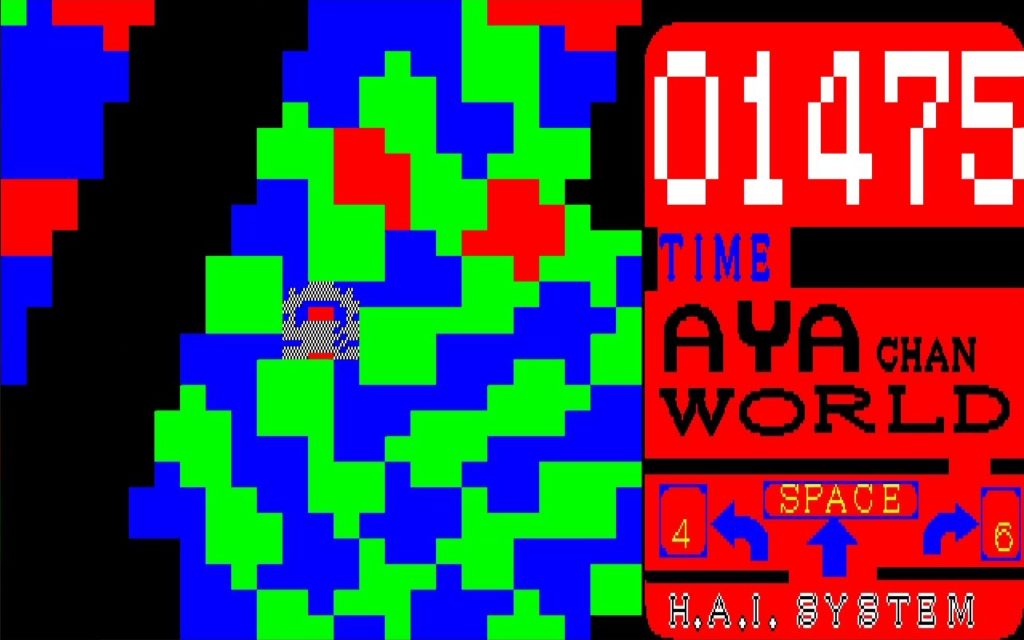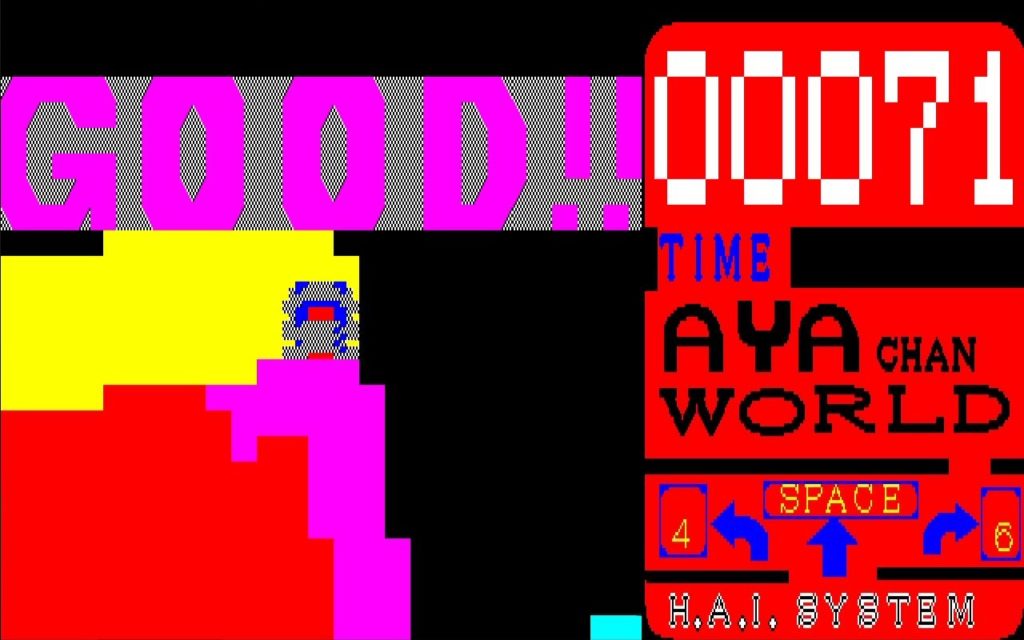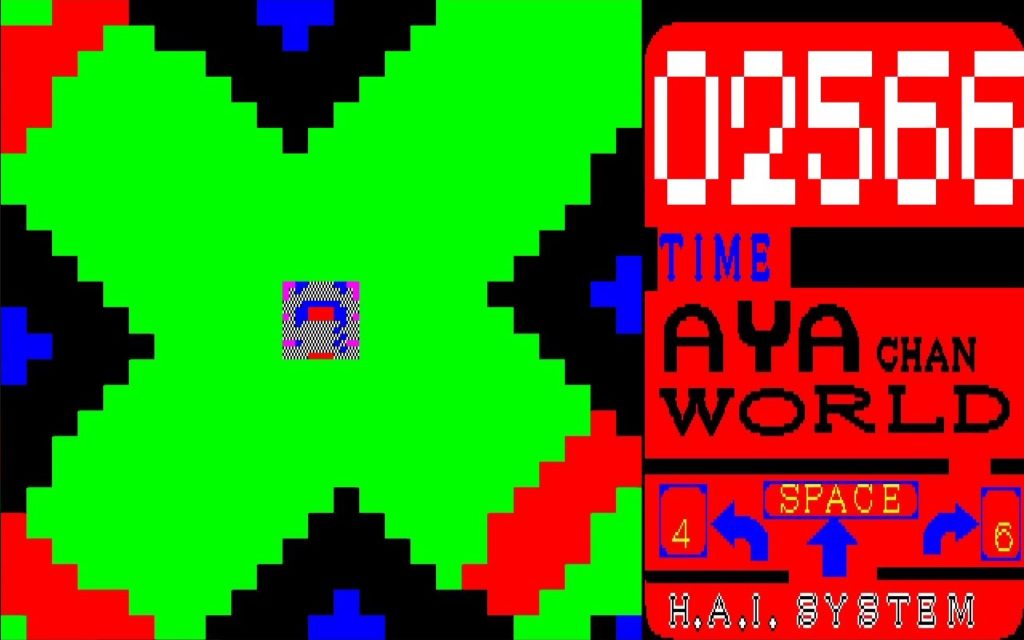The History of Lewd: Aya-chan World
As this series has probably made abundantly clear by this point, when lewd games aren’t being visual novels, they’re often being weird. And I think probably the weirdest one I’ve seen to date is H.A.I. System’s 1989 release for the PC-88, Aya-chan World.
Lewd games for the NEC PC-88 and PC-98 are plentiful, as these platforms are the spiritual home of the late ’80s/early ’90s visual novel and the distinctive visual style that goes with that format. But quite a lot of them are fairly inaccessible to the western audience due to heavy amounts of text in Japanese; we didn’t have these computers over here, so their software never got localised.

Not so in Aya-chan World’s case, though. This is a game that can be… well, let’s say “enjoyed” for the sake of argument, yes… enjoyed by anyone anywhere in the world, because it’s light on the text and, once you get your head around the gameplay, reasonably straightforward to understand. Plus, y’know, pictures of a cute anime girl getting increasingly disrobed are universally appealing, regardless of resolution, colour depth and mother tongue.
Aya-chan World doesn’t appear to have any sort of narrative setup other than the existence of the eponymous Aya-chan, who is both the game’s mascot and your reward for completing each of the game’s stages. She starts out dressed in a cute PE uniform (with Japanese bloomers, of course) and gets increasingly naked (and bound up in bondage knots) as you progress. She never speaks, there’s no explanation as to why she’s there — she just is.

And by the end of the game, it’s not even clear what the point of it all was; sure, she’s completely nude, but there’s no sex scene, no interaction with the player or anything. She’s just there proudly displaying her lady parts, then the screen fades to black and it’s “GAME OVER” for you. Play again? Probably not, no.
As for what comes between the lewd pics, it’s actually sort of interesting. Aya-chan World is often described as a “racing” game in that you’re given a time limit, a car (at least I think it’s a car) to drive and a goal to reach — but in practice it’s actually more of a maze game. Each “course” you race on is not a circuit at all, but rather a top-down open world landscape where the exit (a large yellow block) is hidden somewhere. It’s up to you to track it down before your timer expires.

I say “open world”, but that’s not quite true; your car can drive on any coloured block except black ones, meaning that these act as “walls” of the maze. The perspective means that sometimes you’ll see where you need to go on the other side of one of these walls, so your task becomes finding a way around it — without a map to rely on, you’ll need to make use of landmarks to figure out where you are.
By “landmarks” I mean “arrangements of coloured blocks”, because most of the visuals in Aya-chan World are made up of text characters, giving the game a distinctly chunky-looking appearance. At times, it feels like the map design is trying to stir the imagination and give the impression of being in a realistic environment — the third and final map feels like it’s inspired by city streets, for example — but at others it simply feels like coloured blocks have been thrown around almost at random simply to provide a bit of an illusion of movement or to help the player orient themselves.

The most interesting thing about Aya-chan World’s gameplay is how you control your car. Rather than the top-down perspective being fixed and your car rotating to face various different directions as in most other games of this type in 1989, turning left and right with the 4 and 6 keys on your numeric keypad instead rotates the whole world around your car.
Despite the extremely low resolution of the map graphics, this is actually a surprisingly impressive effect — or at least an unusual one that wasn’t seen much in games of the time. It makes navigation much more interesting than your conventional maze game with four- or eight-directional movement — and this is likely the main reason the game unfolds in a car rather than on foot. I suspect there was a certain degree of “showing off” here — while the effect might look laughable to a modern audience (or even just someone who has seen the Super NES doing its Mode 7 thing) it would have been very memorable to see back in the late ’80s.

There’s one aspect where Aya-chan World really shines, though, and that’s the music. The PC-88 was quite capable of putting out some excellent sound when people knew how to program it properly — and the mystery, unknown programmer from H.A.I. System certainly knew how to make that little beastie sing. The soundtrack to Aya-chan World’s “racing” scenes is absolutely excellent, and really provides a sense of urgency to the otherwise rather pedestrian gameplay. In some ways it’s a bit of a shame that the music is confined to a game as thoroughly unremarkable as Aya-chan World, because it would have fit great with a good shoot ’em up — or indeed a proper racing game.
You’ll be done with Aya-chan World in about ten minutes or so, since its four levels mean there’s not a whole lot of “game” to enjoy here — nor are there all that many lewd pictures, for that matter. There’s the germ of an interesting game here — it might have been interesting to add some collection mechanics similar to those seen in Namco’s Rally-X, for example, as the “rotating” mechanics would have put an interesting spin (no pun intended) on things. But ultimately this is a mildly interesting curio and not much else.
Banging tunes, though.
Join The Discussion
Rice Digital Discord
Rice Digital Twitter
Rice Digital Facebook
Or write us a letter for the Rice Digital Friday Letters Page by clicking here!
Disclosure: Some links in this article may be affiliate links, which means we may earn a small commission if you make a purchase after clicking on them. This is at no additional cost to you and helps support Rice Digital!
- Letter from the Editor: passing the torch - June 30, 2023
- Super Woden GP 2 is looking promising - June 30, 2023
- Inti Creates is making a 32 bit-style Love Live action platformer - June 26, 2023







